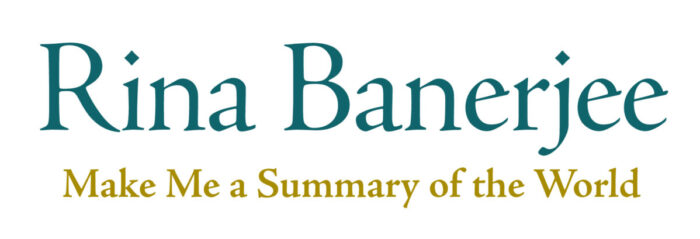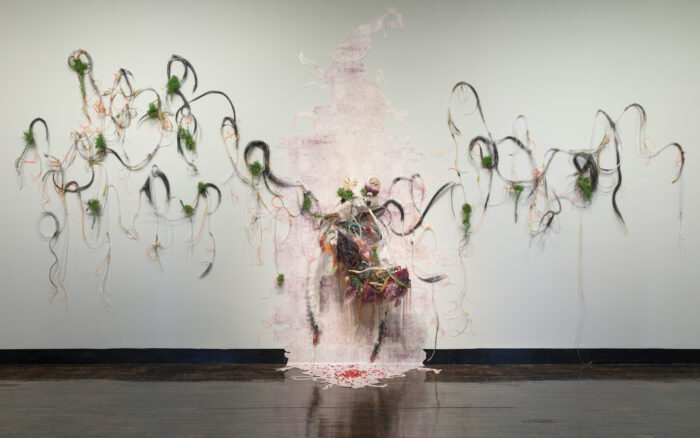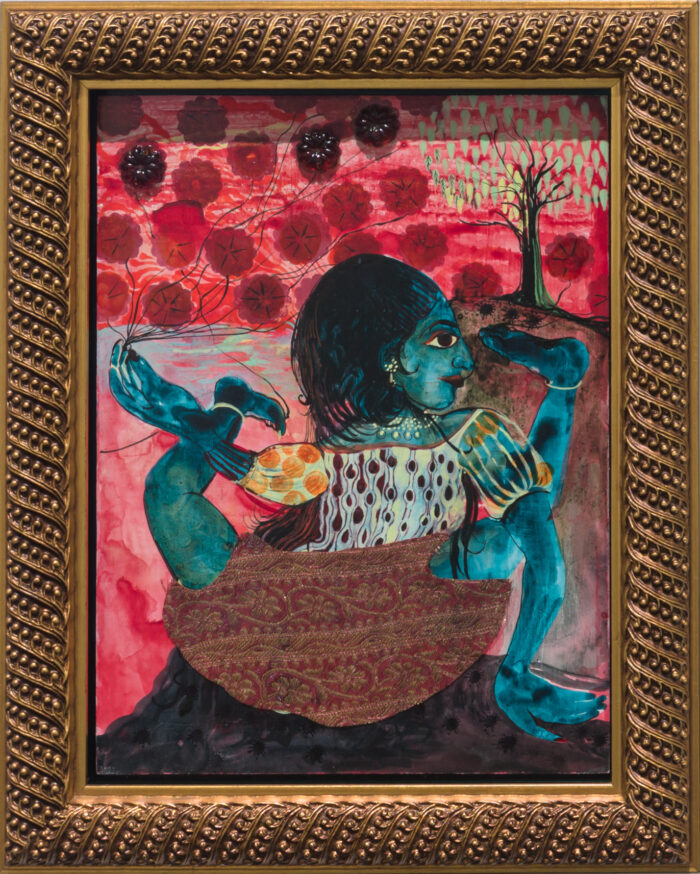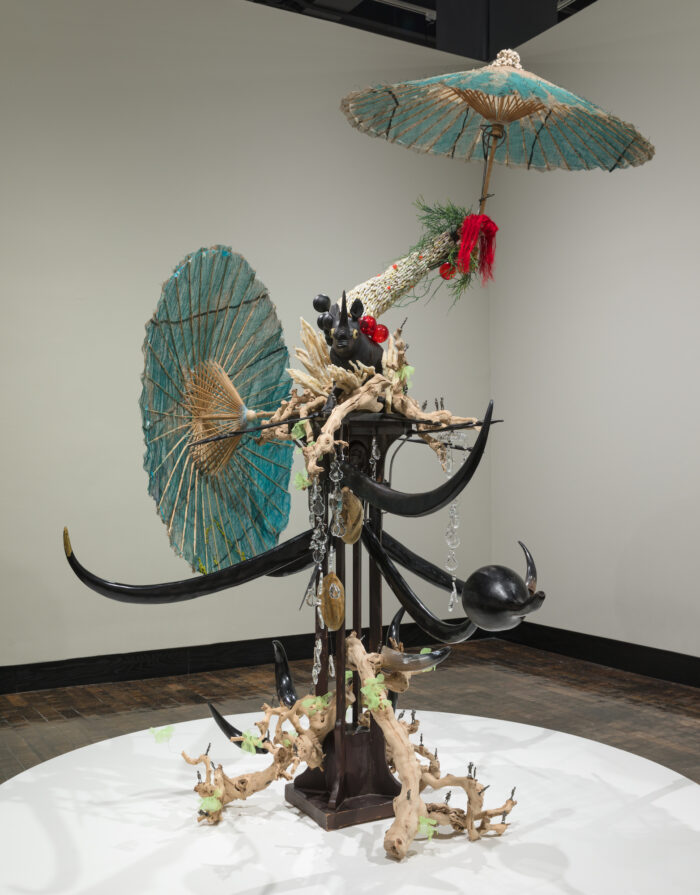
The Frist Art Museum invited community organizations in Nashville to share personal stories, reactions, and creative writing in response to objects in this exhibition.
Responses to
In breathless confinement she wooed an uncertain danger . . . , 2018

Buist Hardison, graphic designer, prop designer, and technical support
Jen-Jen Lin, director, dancer, and choreographer
Sallie Mayne, chair of the board
Jianmei Perkins, lion dancer
Chinese Arts Alliance of Nashville
We come from every corner of the world.
Step back from the artist’s words and listen to your visual inner voice with the understanding that you do not leave your own historical and cultural icons behind.
We may look different from outside.
The complexity of racial and cultural identity as the foreigner evokes fear and uncertainty; a “virus spreading.”
We are the same inside.
A unique entity that blooms and grows, and whose entire depths have yet to be explored.
We long for happiness like you.
An exploding butterfly, a rising Phoenix, has left its cocoon splatted against a wall.
We pursue justice like you.
A clash of cultures, colonialism, and the view of the immigrant.
We bring all of ourselves to you.
How immigrants see themselves; how others see them.
Will you give us compassion and acceptance?
We cannot deny how different identities root us together and ground us.
“Breathless confirmation”
It Dances.
We leave with an experience that expands our understanding of what we see and what the artist intended.

Indira, member
Tennessee Immigrant & Refugee Rights Coalition
My name is Indira. I’m twenty-eight years old and I live in Antioch along with my parents. I’ve been a proud Tennessean for nine years, from the day I arrived in the United States from Nepal.
I was born in Bhutan, but shortly after I was born, my family fled to a refugee camp in Nepal. Because we were Nepali, the Bhutanese government came to separate our family, so my parents ran back to our home country. However, because of the Nepali government at the time, we were forced to stay in a refugee camp, where I spent my entire childhood.
The refugee camp was very difficult to live in. I lived in a small two-room bamboo house. One room was a kitchen, while the other room was where most of us slept. We also never had running water. Every day, we would have to walk down to the river to get a bucket of water to bathe, drink, and survive. Every two weeks, our family would receive sixty pounds of rice and six pounds of sugar. For a family of five, that’s less than a pound of rice per day for three meals daily. It was impossible for my parents to feed us with so little food. Needless to say, we were always hungry.
Now, thanks to the refugee resettlement process, I am in Tennessee. I am a proud blue-collar worker and I will be voting for the first time in 2020.

Rehma, member
Tennessee Immigrant & Refugee Rights Coalition
I am Rehma. I’m thirty-six years old. My family is from Somalia, and our lives were saved thanks to the refugee resettlement program.
I was born in Somalia in 1983. In 1991, war broke out in Somalia and the government collapsed. When it did, different tribes created their own militia. Before fleeing, my family and I were living in a war zone where we watched people die every single day. That year, my family fled to Kenya, where we stayed in a refugee camp for eight years.
Our camp did not have ideal living conditions. We had to collect water off-site every day, and the food that was given to us was not very edible or good. We were given whole grains and lentils to eat every day. Our camp was made out of wood and banana leaves. There was dust everywhere, despite how much we tried to keep it clean. Despite the poor living conditions, we did our best to stay clean, but we were never safe. At night, there were villagers who would break into the camp and steal everyone’s food and belongings. If any were caught in the night, they were aggressive and would tell us we didn’t belong and openly take our things. I lived in fear every single day that I stayed there.
Once I received refugee status along with my family, my whole life changed. I arrived in Nashville and finished high school and college. I work and earn my own money. I’m safe, and I love living here.
Responses to
A World Lost . . . , 2013

Andrés Martínez
Conexión Américas
Water spills out onto the floor—the strength of its current can take us anywhere. Life-giving. Life-taking. The same water which divides us can carry us back home.
The water, which at our borders inches ever closer, grows scant in our lands. Rivers diminish. Inhabitable.
For many, water can only be consumed in plastic. Plastic vessels pollute the substance they once carried. We keep destroying the worlds we claim to have discovered.
Even at the ends of the world someone will offer us a drink.

Eliana Ramage, college mentor at Oasis College Connection
Oasis Center
A World Found
After the deer is shot killed skinned, skin shaved scraped cleaned dried folded wrapped shipped to Nashville, after it is measured cut sewn Cherokee pucker-toe seam tight with waxed artificial sinew, polypropylene, moccasin edges folded down edged in blue felt purple ribbon Czech beads tacked down three at a time over two months’ work, slowly shaping old-style patterns of flowers I can’t name from the mountains they stole from us, after I take them north and west and across the ocean gone eleven years, after the virus the airports closing my parents suddenly old after they say come home now, after I leave in a night in an hour in a moment leave the moccasins in the back of a red painted dresser, after flights tests masks gloves hands dry nails short this is a time to be practical to be alone to not mourn moccasins in a drawer in a dresser in the house of the man before you, after I meet you on the lawn of the State Capitol kiss you where I counted stone steps with my fourth grade class, after I crack the tips of my fingers embroidering a gift for you bright threads from France sturdy black cloth do you know how much you are liked, after I leave in the early morning earrings forgotten on your bedside table tiny nickel dangles colored gold in Thailand bought by the man before you at a Tel Aviv bus station two weeks after my 28th birthday, after I pull onto the ramp that cuts Jefferson Street in this city with the Confederate general on the horse on the highway with the little street named for the old Indian trail cleared through swamps rivers hills this land of mine mountains over real gold, after exit 209B then the roundabout on Music Square pass a dollar out the window to the man selling newspapers pass the girls in masks and yoga pants arms around each other laughing at the stoplight I have not hugged my parents in seven months once I got on the kitchen floor and held their feet, after I turn the radio up loud sing remember I don’t know the words remember I was once gone remember moccasins six thousand miles away, after this and at last imagine, I was once a girl counting steps on a field trip up a hill, rolling down grass freshly mowed sharp a thousand tiny cuts on my skin screaming and laughing at the pain how it kept coming, how I loved it, this and the long walk home, imagine home, imagine this.
A response to
I am all that could stretch, 2014

Namratha Niranjan
Catholic Charities of Tennessee
I am all that I could stretch.
I am all that I could stretch
Across the lines drawn for me
Vivid reds and blues
Tug me apart and
Beseech me to choose who
I am meant to be.
Behind me lies the crimson bubbles
Lives of generations
Of expectations
Their strands laced into my skin
A knit work woven tapestry
Of my heart and where I’ve been
Before me lies a sweet scent
Vanilla and mint appear
Where I was sandalwood and chili
I become drawn towards
The refuge of a billowy tree so near
As gnarls of roots and earth
Anchor its soul into place
Arms wave wildly
Branching across the sky
Threading itself into a crimson space
I am all that I could stretch
Until I can stretch no more
The threads of my saree slowly pull apart
As I untangle the ties that bind me
And I am undone.
A response to
Make Me a Summary of the World

Mohera Narimetla, teacher
Upasana Performing Arts Center
Make Me a Summary of the World was a profoundly moving, validating, and transcending experience. As an Indian woman with a background similar to Banerjee’s, throughout my adult life I have found myself contemplating many of the topics discussed in her work. In light of an immense lack of diverse representation in the arts, particularly with respect to the South Asian community, Make Me a Summary of the World was a truly beautiful and emotional surprise. Viewing the exhibit, I felt not only seen, but understood. It was as though I could see my life reflected through Banerjee’s art—something I had never experienced until now.
The exhibit was both a visually stunning and thought-provoking display of paintings and sculptures that utilized the most unique and unconventional combinations of materials. Not only was I mesmerized by her attention to detail, but I was equally captivated with the inquisitive nature of her work. The striking contrast between man-made, industrial pieces and embroidered, organic fabrics was not only a reflection of Banerjee’s multifaceted background, but also a social commentary on colonization, gender, identity, exploitation, and much more. She utilized the complex nature of these issues to her advantage through various forms of contrasting imagery, highlighting both the virtues and violence of Eurocentricity while also paying homage to her Indian heritage.
A thoughtful and mesmerizing experience, Make Me a Summary of the World represents precisely what I hope to see more of from artists with unique cultural and experiential backgrounds.
